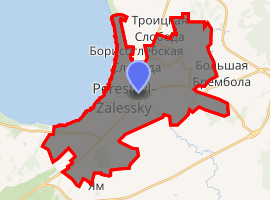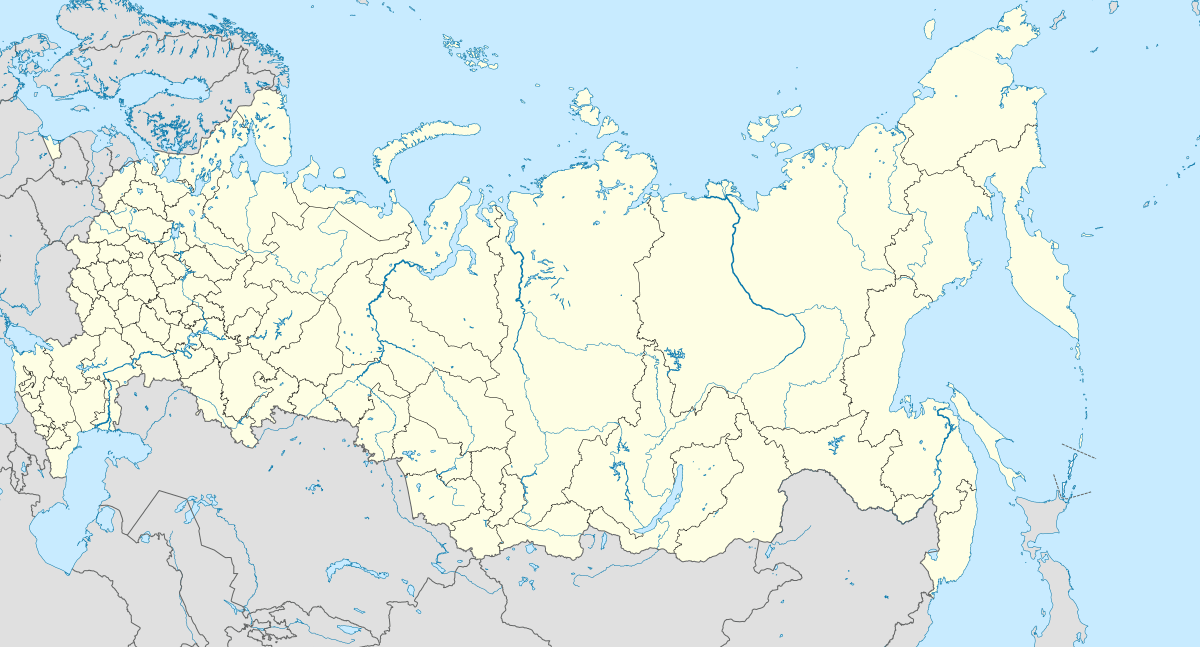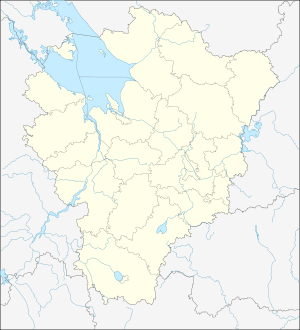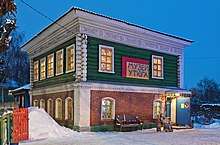Pereslavl-Zalessky
Pereslavl-Zalessky (Russian: Переславль-Залесский, IPA: [pʲɪrʲɪˈslavlʲ zɐˈlʲɛskʲɪj], lit. Pereslavl beyond the woods), also known as Pereyaslavl-Zalessky, is a town in Yaroslavl Oblast, Russia, located on the main Moscow–Yaroslavl road and on the southeastern shore of Lake Pleshcheyevo at the mouth of the Trubezh River. Population: 41,925 (2010 Census);[3] 43,379 (2002 Census);[8] 42,331 (1989 Census).[9]
Pereslavl-Zalessky Переславль-Залесский | |
|---|---|
Town[1] | |
 View of Pereslavl-Zalessky | |
.png) Flag .png) Coat of arms | |
Location of Pereslavl-Zalessky 
| |
 Pereslavl-Zalessky Location of Pereslavl-Zalessky  Pereslavl-Zalessky Pereslavl-Zalessky (Yaroslavl Oblast) | |
| Coordinates: 56°44′N 38°51′E | |
| Country | Russia |
| Federal subject | Yaroslavl Oblast[1] |
| Founded | 1152 |
| Government | |
| • Body | Town Duma |
| • Mayor | Denis Koshurnikov |
| Area | |
| • Total | 22.5 km2 (8.7 sq mi) |
| Elevation | 142 m (466 ft) |
| Population | |
| • Total | 41,925 |
| • Estimate (2018)[4] | 38,649 (-7.8%) |
| • Density | 1,900/km2 (4,800/sq mi) |
| • Subordinated to | town of oblast significance of Pereslavl-Zalessky[1] |
| • Capital of | Pereslavsky District[1], town of oblast significance of Pereslavl-Zalessky[1] |
| • Urban okrug | Pereslavl-Zalessky Urban Okrug[5] |
| • Capital of | Pereslavl-Zalessky Urban Okrug[5], Pereslavsky Municipal District |
| Time zone | UTC+3 (MSK |
| Postal code(s)[7] | 152020, 152021, 152023–152026 |
| Dialing code(s) | +7 48535 |
| OKTMO ID | 78705000001 |
| Website | www |
Geography
Pereslavl-Zalessky is located in south of Yaroslavl Oblast, near a border with Moscow Oblast, 140 kilometres (87 mi) northeast of Moscow, and 139 kilometres (86 mi) southwest of Yaroslavl.
Climate
Climate of Pereslavl-Zalessky is humid continental: long, cold and snowy winters and short, warm and rainy summers. Average temperatures range from −12 °C (10 °F) in January to +18 °C (64 °F) in July.
History
Known as Pereyaslavl until the 15th century, it was founded in 1152 by Prince Yury Dolgoruky as a projected capital of Zalesye. In 1175–1302, the town was the seat of the Principality of Northern Pereyaslavl (not to be confused with the Principality of Pereyaslavl in modern-day Ukraine). In 1302, it became a part of the Grand Duchy of Moscow. Pereslavl-Zalessky was devastated numerous times by the Mongols between the mid-13th century and the early 15th century. In 1611–1612, it suffered from the Polish invasion.[10]
In 1688–1693, Peter the Great built his famous "fun flotilla" on Lake Pleshcheyevo for his own amusement, including the so-called Peter's little boat, which would be considered the forefather of the Russian fleet. The Botik (small boat) museum chronicles the history of the first Russian fleet and keeps one of the original model boats.
In 1708, the town became a part of Moscow Governorate.[11]
Just before the Moscow Olympics in 1980, the city of Moscow rounded up a large number of people it considered 'undesirable', many thousands, and decreed that they must be moved at least 120km from Moscow in order to improve the city's image. Pereslavl is approx 130km from Moscow and as such the population of the town soared prior to the Olympics.
Administrative and municipal status
Within the framework of administrative divisions, Pereslavl-Zalessky serves as the administrative center of Pereslavsky District, even though it is not a part of it.[1] As an administrative division, it is incorporated separately as the town of oblast significance of Pereslavl-Zalessky—an administrative unit with the status equal to that of the districts.[1] As a municipal division, the town of oblast significance of Pereslavl-Zalessky is incorporated as Pereslavl-Zalessky Urban Okrug.[5]
Science and education
There is Institute for Program Systems of the Russian Academy of Sciences in the town. The University of Pereslavl is also based in the town.
Sights and architecture

The town is a part of the Golden Ring of Russia. Monuments of church architecture include six architecture complex convents and nine churches. Notable historic buildings are:
- white stone Savior's Cathedral (1152–1157)
- Church of Metropolitan Peter (1585)
- Troitse-Danilov Monastery (16th–18th centuries)
- Nikitsky Monastery (16th–19th centuries)
- Feodorovsky Monastery (16th–19th centuries)
- Goritsky Monastery (17th–18th centuries)
- Museum and exhibits
The town has a bewildering array of 'museums' that cater to the tourist trade in the summer, some are quite bizarre, the museum of Cunning and Wit for example. If you can think of it, they have a museum for it in Pereslavl.
- Museum-Preserve of Pereslavl-Zalessky (in Goritsky Monastery)
- Museum–Estate "The Little Boat of Peter the Great"
- The Pereslavl Arboretum
- Museum of Flat Irons
- The Museum of Kettles
- The Museum of Steam Engines

The Kleshin complex, an archaeological monument, is located about 2 kilometers (1.2 mi) from the town proper.
The original earthworks (which are still quite substantial) from the defensive wall that circled the town originally are still here, it is possible to walk along these defensive structures. As are portions if the original road that was at its base. Although identifying a 12th-century road from a modern one would be a task in itself. Lake Pleshcheyevo
The town sits on the banks of Lake Pleschayevo, a large lake that draws tourists throughout the season. Kite surfing is particularly popular, as is camping.
Notable people
- Alexander Nevsky, prince
- Dmitry Kardovsky, artist
- Pavel Kolendas, artist
- Mikhail Koshkin, designer of the T-34 tank
- Leonid Kurchevsky, weapon engineer
- Nicetas Stylites, saint
- Alexander Petrov, actor
References
Notes
- Law #12-z
- Территориальный орган Федеральной службы государственной статистики по Ярославской области. Ярославская область в цифрах 2012. Краткий статистический сборник Archived May 17, 2017, at the Wayback Machine (in Russian)
- Russian Federal State Statistics Service (2011). "Всероссийская перепись населения 2010 года. Том 1" [2010 All-Russian Population Census, vol. 1]. Всероссийская перепись населения 2010 года [2010 All-Russia Population Census] (in Russian). Federal State Statistics Service.
- "26. Численность постоянного населения Российской Федерации по муниципальным образованиям на 1 января 2018 года". Federal State Statistics Service. Retrieved January 23, 2019.
- Law #65-z
- "Об исчислении времени". Официальный интернет-портал правовой информации (in Russian). June 3, 2011. Retrieved January 19, 2019.
- Почта России. Информационно-вычислительный центр ОАСУ РПО. (Russian Post). Поиск объектов почтовой связи (Postal Objects Search) (in Russian)
- Russian Federal State Statistics Service (May 21, 2004). "Численность населения России, субъектов Российской Федерации в составе федеральных округов, районов, городских поселений, сельских населённых пунктов – районных центров и сельских населённых пунктов с населением 3 тысячи и более человек" [Population of Russia, Its Federal Districts, Federal Subjects, Districts, Urban Localities, Rural Localities—Administrative Centers, and Rural Localities with Population of Over 3,000] (XLS). Всероссийская перепись населения 2002 года [All-Russia Population Census of 2002] (in Russian).
- "Всесоюзная перепись населения 1989 г. Численность наличного населения союзных и автономных республик, автономных областей и округов, краёв, областей, районов, городских поселений и сёл-райцентров" [All Union Population Census of 1989: Present Population of Union and Autonomous Republics, Autonomous Oblasts and Okrugs, Krais, Oblasts, Districts, Urban Settlements, and Villages Serving as District Administrative Centers]. Всесоюзная перепись населения 1989 года [All-Union Population Census of 1989] (in Russian). Институт демографии Национального исследовательского университета: Высшая школа экономики [Institute of Demography at the National Research University: Higher School of Economics]. 1989 – via Demoscope Weekly.
- Brumfield, W. (August 9, 2019). "The extraordinary revival of the Convent of St. Theodore in Pereslavl-Zalessky". Russia Beyond the Headlines. Retrieved January 29, 2020.
- Указ об учреждении губерний и о росписании к ним городов (in Russian)
Sources
- Государственная Дума Ярославской области. Закон №12-з от 7 февраля 2002 г «Об административно-территориальном устройстве Ярославской области и порядке его изменения», в ред. Закона №67-з от 21 декабря 2012 г. «О внесении изменений в отдельные законодательные акты Ярославской области и признании утратившими силу отдельных законодательных актов (положений законодательных актов) Ярославской области». Вступил в силу через шесть месяцев со дня официального опубликования. Опубликован: "Губернские вести", №11, 15 февраля 2002 г. (State Duma of Yaroslavl Oblast. Law #12-z of February 7, 2002 On the Administrative-Territorial Structure of Yaroslavl Oblast and on the Procedures of Its Change, as amended by the Law #67-z of December 21, 2012 On Amending Various Legislative Acts of Yaroslavl Oblast and on Abrogation of Various Legislative Acts (Clauses of Legislative Acts) of Yaroslavl Oblast. Effective as of the day six months from the day of the official publication.).
- Государственная Дума Ярославской области. Закон №65-з от 21 декабря 2004 г. «О наименованиях, границах и статусе муниципальных образований Ярославской области», в ред. Закона №59-з от 28 декабря 2011 г «Об изменении статуса рабочего посёлка Песочное Рыбинского района и о внесении изменений в отдельные законодательные акты Ярославской области». Вступил в силу через 10 дней со дня официального опубликования. Опубликован: "Губернские вести", №70, 23 декабря 2004 г. (State Duma of Yaroslavl Oblast. Law #65-z of December 21, 2004 On the Names, Borders, and Status of the Municipal Formations of Yaroslavl Oblast, as amended by the Law #59-z of December 28, 2011 On Changing the Status of the Work Settlement of Pesochnoye of Rybinsky District and on Amending Various Legislative Acts of Yaroslavl Oblast. Effective as of after 10 days from the day of the official publication.).
Further reading
- (in Russian) Pereslavl-Zalessky. Materials for the History of the 17th and 18th centuries (1884) (Переславль-Залесский. Материалы для истории города XVII и XVIII столетий) at Runivers.ru in DjVu and PDF formats